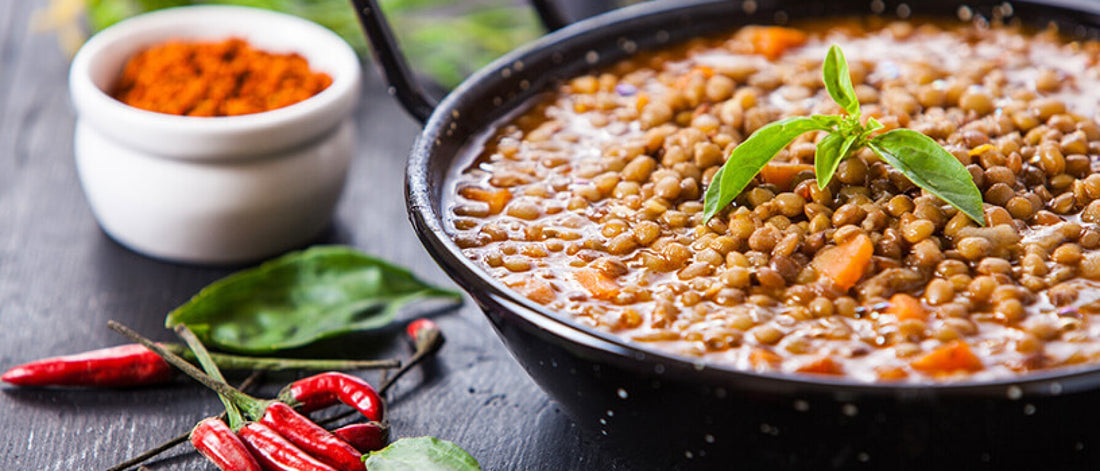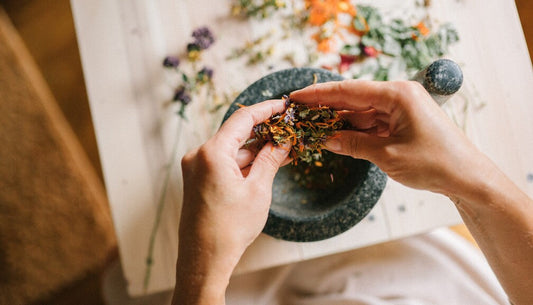The changing of the seasons is always a marvelous sight to behold. If you live in an area where winter is bold and proud, spring is a long-awaited and welcoming season. The first flowers start to bloom, snow turns into rain, and the grass starts changing from brown to green once again. And as much as you’d like to trade in your boots for flip-flops, the temperamental weather that spring brings can have you changing clothes several times a day, not to mention wreak havoc on your immune system.
Spring typically comes with cool weather and a lot of moisture. The earth is awakening once again and produces a lot of pollen and dust. The combination of moisture and dust can make the air quite heavy.
The Ayurvedic dosha type most affected by spring is Kapha, derived from the elements of water and earth. A person whose primary dosha is Kapha (take the Dosha Quiz to find out your dominant dosha) has higher amounts of water and earth than space, air, and fire. If Kapha types experience increased amounts of water and earth in their mind and body, imbalances can occur because they don’t need more of what they already have.
Try following these five tips to lift the heaviness of Kapha, so you can feel your best this season.
A Kapha-pacifying diet will include increased amounts of the bitter, pungent, and astringent tastes, and less of the sweet, sour, and salty tastes.
The bitter taste helps to detoxify the body and includes:
If you are prone to asthma and bronchial congestion, drink licorice tea daily. You can mix one teaspoon of licorice root in a cup of hot water and let it steep for a few minutes before drinking. Another tea you can drink daily is a ready-made Kapha pacifying tea, which usually includes a combination of:
*Editor’s Note: The information in this article is intended for your educational use only; does not necessarily reflect the opinions of the Chopra Center's Mind-Body Medical Group; and is not a substitute for professional medical advice, diagnosis, or treatment. Always seek the advice of your physician or other qualified health providers with any questions you may have regarding a medical condition and before undertaking any diet, supplement, fitness, or other health program.
Reinvigorate your entire being with the best wellness practices for your unique mind-body type at our six-day Perfect Health retreat. Learn More.
Spring typically comes with cool weather and a lot of moisture. The earth is awakening once again and produces a lot of pollen and dust. The combination of moisture and dust can make the air quite heavy.
The Ayurvedic dosha type most affected by spring is Kapha, derived from the elements of water and earth. A person whose primary dosha is Kapha (take the Dosha Quiz to find out your dominant dosha) has higher amounts of water and earth than space, air, and fire. If Kapha types experience increased amounts of water and earth in their mind and body, imbalances can occur because they don’t need more of what they already have.
Try following these five tips to lift the heaviness of Kapha, so you can feel your best this season.
1. Get Moving
Kapha types typically love to sit around and read or watch movies. While that may have been seasonally appropriate in winter, spring is a time to move out some of that lethargic energy. You might also be feeling the extra weight gain from the past several months. Take a brisk walk in the morning and evening. To give yourself an even greater workout, hold onto two-pound weights as you walk. Take along a Vata or Pitta friend to get you motivated. Kapha types also do well with hot yoga and more vigorous types of exercise such as Zumba or weight lifting.2. Practice Walking Meditation
While seated meditation is great for everyone, Kapha types can benefit from a walking meditation. Put on some meditation or yoga music and find a walking path with lots of flowers and trees. As a Kapha, you respond best to the senses of taste and smell. As you walk through your meditation, stop and smell the flowers and plantlife. It will invigorate you and keep you motivated on your path.3. Perform Self-Massage
You can stimulate your slow-moving Kapha energy by performing a self-massage with raw silk gloves called garshana gloves. This method is also referred to as dry brushing. A garshana massage exfoliates your skin, reduces cellulite, and eliminates toxins from your body by stimulating your lymphatic system. As you massage, you will do fast long strokes on the limbs and bigger surfaces of your body, and circles around the joints and stomach. Follow these guidelines to perform the massage.4. Eat a Kapha-Pacifying Diet
During the transition from winter to spring, most people do well with a lighter diet. For a Kapha type, eating lighter foods and less food helps move out excess Kapha. Because of their slower metabolism, Kaphas can do well with only two meals per day and no snacking. The first meal should be late in the morning after 10 a.m., and the second meal of the day can be in the afternoon to early evening, around 5 p.m.A Kapha-pacifying diet will include increased amounts of the bitter, pungent, and astringent tastes, and less of the sweet, sour, and salty tastes.
The bitter taste helps to detoxify the body and includes:
- Yellow and green vegetables
- Bitter teas
- Coffees
- Garlic
- Onion
- Hot peppers
- Spices
- Beans
- Lentils
- Berries
- Dark greens
- Whole grains
- Dairy
- Sugar
- Meat
- Processed foods
5. Reduce Seasonal Allergies and Excess Mucus
Kapha types often suffer from the inflammation and excess mucus that comes with seasonal allergies. Use a neti or nasal wash pot with one-fourth teaspoon of sea salt every day upon awakening. After your neti wash, rub 3 to 5 drops of warm ghee or sesame oil into your nostrils. This will keep your sinuses clean and reduce bacterial growth.If you are prone to asthma and bronchial congestion, drink licorice tea daily. You can mix one teaspoon of licorice root in a cup of hot water and let it steep for a few minutes before drinking. Another tea you can drink daily is a ready-made Kapha pacifying tea, which usually includes a combination of:
- Ginger
- Clove
- Pepper
- Cardamom
- Turmeric
*Editor’s Note: The information in this article is intended for your educational use only; does not necessarily reflect the opinions of the Chopra Center's Mind-Body Medical Group; and is not a substitute for professional medical advice, diagnosis, or treatment. Always seek the advice of your physician or other qualified health providers with any questions you may have regarding a medical condition and before undertaking any diet, supplement, fitness, or other health program.
Reinvigorate your entire being with the best wellness practices for your unique mind-body type at our six-day Perfect Health retreat. Learn More.






















